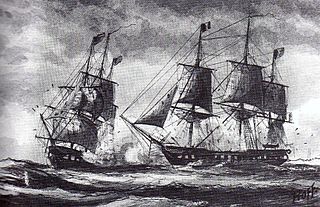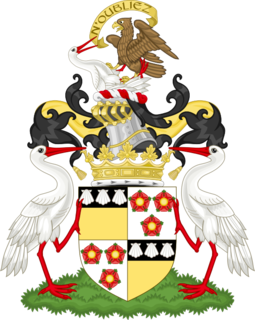
The current HMS Montrose is the eighth of the sixteen-ship Type 23 or Duke class of frigates, of the Royal Navy, named after the Duke of Montrose. She was laid down in November 1989 by Yarrow Shipbuilders on the Clyde, and was launched on 31 July 1992 by Edith Rifkind, wife of Malcolm Rifkind, Secretary of State for Defence. She commissioned into service in June 1994.

USS President was a wooden-hulled, three-masted heavy frigate of the United States Navy, nominally rated at 44 guns. She was launched in April 1800 from a shipyard in New York City. President was one of the original six frigates whose construction the Naval Act of 1794 had authorized, and she was the last to be completed. The name "President" was among ten names submitted to President George Washington by Secretary of War Timothy Pickering in March of 1795 for the frigates that were to be constructed.Joshua Humphreys designed these frigates to be the young Navy's capital ships, and so President and her sisters were larger and more heavily armed and built than standard frigates of the period. Forman Cheeseman, and later Christian Bergh were in charge of her construction. Her first duties with the newly formed United States Navy were to provide protection for American merchant shipping during the Quasi War with France and to engage in a punitive expedition against the Barbary pirates in the First Barbary War.

HMS Marlborough was a Duke-class Type 23 frigate of the Royal Navy, and the sixth ship to bear the name. She was named after John Churchill, 1st Duke of Marlborough. The ship entered service with the Royal Navy in 1991 and served in the Middle East. The frigate was taken out of service in 2005 and sold to Chile. The vessel entered service with the Chilean Navy in 2008 as Almirante Condell. The ship remains in service.

L'Insurgente was a 40-gun Sémillante-class frigate of the French Navy, launched in 1793. During the Quasi War with the United States, the United States Navy frigate USS Constellation, with Captain Thomas Truxtun in command, captured her off the island of Nevis. After her capture she served in the United States Navy as USS Insurgent, patrolling the waters in the West Indies. In September 1800 she was caught up in a severe storm and was presumed lost at sea.
Adventure Galley, also known as Adventure, was an English sailing ship captained by William Kidd, the notorious privateer. She was a type of hybrid ship that combined square rigged sails with oars to give her manoeuvrability in both windy and calm conditions. The vessel was launched at the end of 1695 and was acquired by Kidd the following year to serve in his privateering venture. Between April 1696 and April 1698, she travelled thousands of miles across the Atlantic and Indian Oceans in search of pirates but failed to find any until nearly the end of her travels. Instead, Kidd himself turned pirate in desperation at not having obtained any prizes. Adventure Galley succeeded in capturing two vessels off India and brought them back to Madagascar, but by the spring of 1698 the ship's hull had become so rotten and leaky that she was no longer seaworthy. She was stripped of anything movable and sunk off the north-eastern coast of Madagascar. Her remains have not yet been located.

Étoile was a 44-gun frigate of the French Navy, launched in 1813. The British captured her in 1814 and the Royal Navy took her into service as HMS Topaze. She did not go to sea again until 1818, and was paid off in 1822. She served as a receiving ship until 1850 and was broken up in 1851.

Lautaro was initially the British East Indiaman Windham, built by Perry, Wells & Green at the Blackwall Shipyard for the East India Company (EIC) and launched in 1800. She made seven voyages to India, Ceylon, and China for the EIC. In 1809-10, the French captured her twice, but the British also recaptured her twice. The Chilean Navy bought her in 1818 and she then served in the Chilean Navy, taking part in several actions during the liberation wars in Chile and Peru. From 1824 she was a training ship until she was sold in 1828.
Exeter was a three-decker East Indiaman built by Perry and launched in 1792. She made eight voyages to the East Indies for the East India Company (EIC). More unusually, on separate voyages she captured a French frigate and participated in the Battle of Pulo Aura. She was sold for breaking up in 1811.
Anne, also known as Ann, was an 18th-century Spanish sailing ship that the British had captured in 1799. The British Navy Board engaged her to transport convicts from Cork in Ireland to the penal colony of New South Wales in Australia for one voyage from 1800 to 1801. During this voyage she was possibly present, although she did not participate, in a notable action against a squadron of three French frigates. She then made one voyage for the British East India Company (EIC).
Royal Charlotte was launched in 1789 as an East Indiaman for the British East India Company (EIC). She made two trips to China for the EIC and on the second of these, after the outbreak of war with France in 1793, assisted at the British capture of Pondicherry. Then, the Admiralty, desirous of quickly building up the Royal Navy, purchased a number of commercial vessels, including nine East Indiamen, to meet the need for small two-decker fourth rates to serve as convoy escorts. The Admiralty purchased Royal Charlotte in 1795 and renamed her HMS Malabar. She made a trip to the West Indies where she was the lead ship of a small squadron that captured some Dutch colonies. She foundered in 1796 while escorting a convoy in the North Atlantic.
Three ships with the name Osterley served the British East India Company (EIC) as an East Indiaman between 1758 and 1800:
The Action of 10 September 1782 was a minor engagement between five merchant vessels — four East Indiamen of the British East India Company and a country-ship — on the one side, and a French frigate on the other. The action resulted in only a few casualties and was inconclusive. What was noteworthy was that the Indiamen sought out the French man-of-war and attacked it; it would have been more usual for the merchantmen to have avoided combat as they had little to gain from a battle.

Nonsuch was launched at Calcutta in 1781 as the first large vessel built there. She was designed to serve as either a merchantman or a man-of-war. She spent the first 12 years of her career as a merchant vessel, carrying opium to China amongst other cargoes. After the outbreak of the French Revolutionary Wars in 1793 her owner frequently hired her out as an armed ship to the British East India Company (EIC). She participated in an engagement with a French naval squadron and recaptured an East Indiaman. She also made two voyages for the EIC. After the Peace of Amiens in 1802 the EIC paid her off; as she was being hauled into a dockyard for repairs she was damaged and the decision was taken to break her up.
Georgiana was launched in 1791. She served as a merchantman, packet ship for the British East India Company (EIC), a whaler, a warship of the navy of the United States of America, and a merchant vessel again. She was condemned in 1818 as leaky and sold.
Several vessels have been named Ruby:
Charlotte was built at the Bombay Dockyard in 1803. She spent most of her career as a country ship, trading between India and China. The French captured her in 1804 but she returned to British hands. She was wrecked in 1851.
Several ships have been named Hannah:
Numerous vessels have been named Hope for the emotion or virtue Hope:
Duke of Montrose was a Falmouth packet launched in 1804. She was in four single-ship actions. She was able to drive off American privateers twice. An American frigate captured her in 1813 but gave her up to her crew and the crews of other vessels the frigate had captured. A French frigate also captured her and gave her up after disarming her. She was wrecked at Barbados in 1815.









